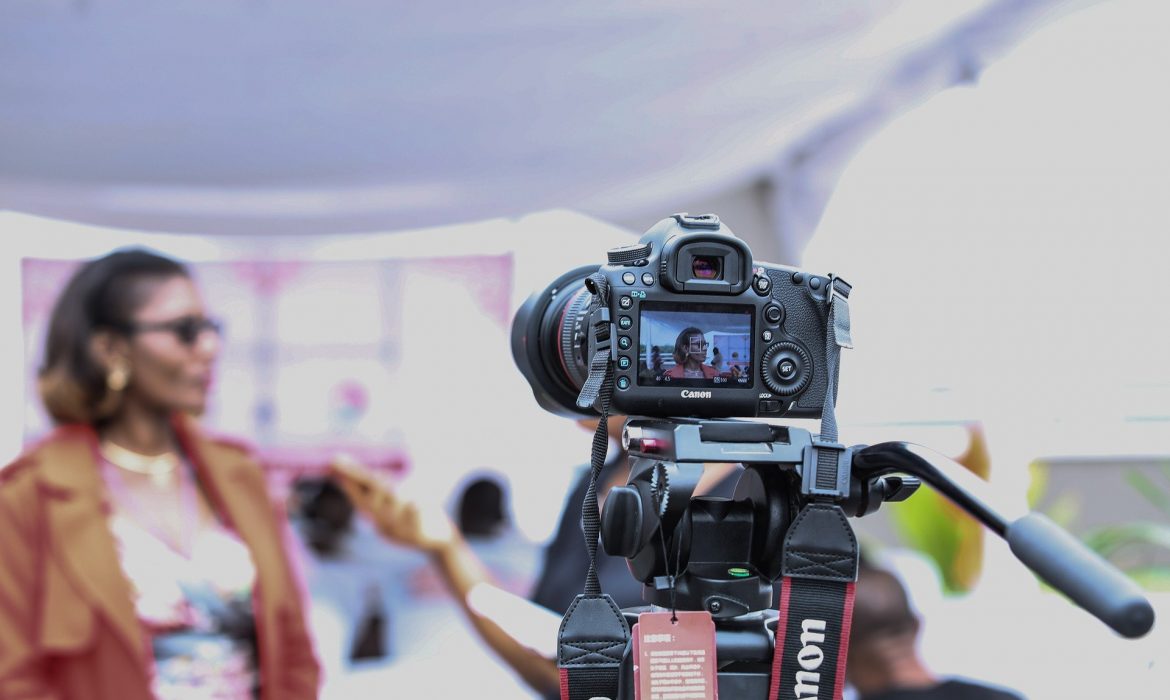Your essential read if you’ve ever wondered how to make traditional TV cool again!
In the US, adults are spending more and more time with different kinds of digital media[1], while their attention is also shifting from traditional TV to PCs, and smartphones and tablets connected to the web.
What’s interesting is that while there is an enormous variety of traditionally broadcast TV channels to choose from (a monthly average of 206 channels according to Nielsen research), US adults only actively watch 20 of them[2]. In other Nielsen data for US adults, while TV still rules people are using a broader range of devices for home entertainment, with apps and the web now hot on the heels of TV. The total time spent on other devices now outweighs time spent watching traditional TV.
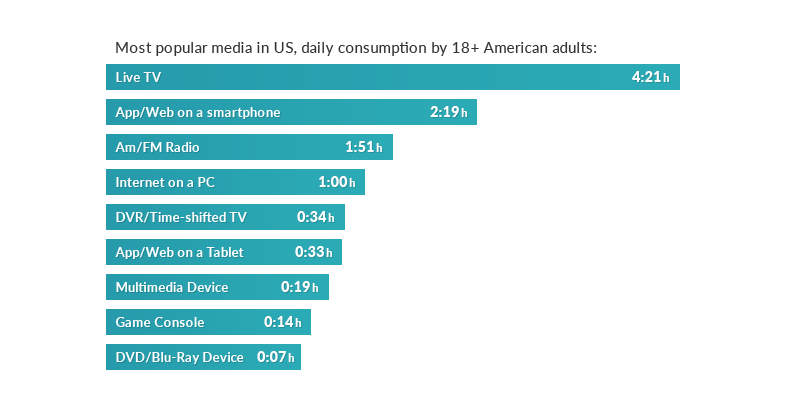
If you look at the behaviour of younger viewers in particular, what’s evident is that Generation Z (12-20 year olds) consume the smallest amount of traditional TV, either when live or time shifted/recorded. Arguably, this is the effect of a new and younger audience becoming bored (or simply not accustomed to) traditional TV’s linear approach, which might be a challenging argument to accept if you work in broadcast TV.
To help you to understand, let’s look at this analogy. Nowadays, traditional TV is like a middle-aged guy trying to gain popularity on Snapchat – the technology feels the same, the rules are clear, but somehow it simply doesn’t work for him. What he says and does is simply not attractive enough for the audience on that platform. (Believe me, I feel like this guy at times as I don’t always understand the buzz surrounding Snapchat.)
Back in the broadcasting world, you may be more than conscious that new ways of consuming media are coming. You might feel they’re already here. Yet, with huge resources, varied schedules and all the broadcasting technology at your disposal, perhaps you’re still left wondering why traditional TV isn’t as attractive as it was? Perhaps you can’t quite put your finger on why this is the case.
Let’s take a closer look at some of the opportunities and threats below.
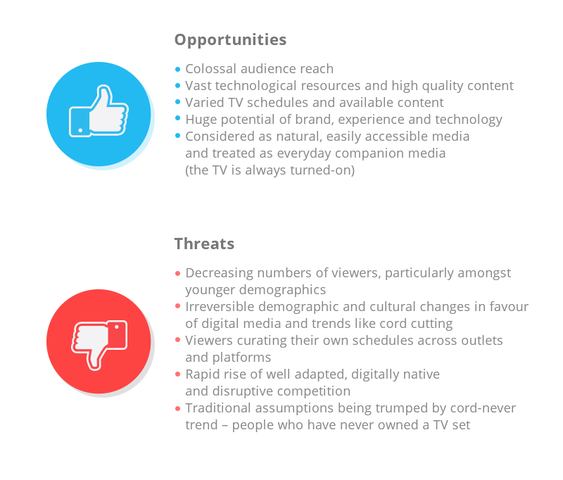
What’s common amongst the above threats is the impact of the internet and the smartphone. Viewers now have more flexibility – they can watch and interact with digital, web TV and OTTs in any manner they like, where and when they want, and on the device of their choosing.
Why should viewers miss the ol’ set-top box? So, is this the end of linear TV as we know it? It’s too early to jump to this kind of conclusion. For sure, there are now many more options to traditional TV and improvements that linear broadcasters should make to stay in the game.
Let’s dive in and check out six ways you can sharpen your focus to stay alive in this fast-paced, digital-first world.
- Make the web your friend and ally
- Use your TV brand as leverage
- Your experience is your advantage
- Retain your loyal viewers
- Work across platforms
- Conversations – it takes (at least) two to tango!
First things first, if you haven’t done so already, make your brand more visible online by expanding your social media presence. Take time to reconsider your options, making an audit of your efforts to date to identify what’s worked and what hasn’t.
When relaunching your social media presence, have a video content strategy in place that puts you in a position to start streaming and producing videos for social channels. Streams and social videos make for highly engaging web content and, as a broadcaster, you are ideally placed to create a constant stream of such content. To do so, choose social video production tools and platforms that will fit your needs, and ones that will enable you to stream and produce videos from live content and any archival content you want to use.

Live streams and videos are undoubtedly the most engaging types of content. When checking Facebook streaming results for one of our Tellyo clients, we learned that it is possible to create up to 400 interactions per 1,000 fans with live video, while images were able to reach only 6 interactions per 1,000. For further interesting stats, check out the case studies section on our website.
Having a strong and recognisable brand is unbelievably helpful online – it will help you to stand out. If your logo is well known, you should remember to place it on your video content, so that when this spreads around the internet you get the brand recognition you deserve. With a little bit of luck, many viewers will trace your quality content back to your channel or Facebook page.
Being experienced with video production and everything broadcasting related is a huge advantage over your competitors. Being able to create TV-grade video content, while having an experienced team and professional equipment are all strong assets. However, these assets aren’t enough to be successful on the web and in the social media, but they will help a lot. You can always talk to us here at Tellyo about how to combine your experience with an advanced, social video production platform such as ours.
Have you ever heard of the Pareto principle[4]? Better known as the 80/20 rule which states that 80% of the effects come from 20% of the causes. Translating this into broadcast language – it means that 20% of your audience is responsible for 80% of your views. Therefore, if you want to be successful in social media, play to your core audience. Let them know that soon they will be able to watch their favourite shows and events via other media as well.
Remember that social media isn’t monolithic – it’s decentralised and each platform has its own properties. You shouldn’t copy and paste your strategy from one channel to another. For example, if you decide to stream content then use YouTube, Facebook or Twitter, but only YouTube will be a good place as a platform to host clips for a longer period. Facebook will give you a big audience and visibility initially, but people will not find your videos once they vanish from timelines.
Your audience has a voice, and it will use it. In comments, emails and chats, they will use each possible channel to give you their opinion about your content. And that’s a good thing – a gold mine of interactions and engagement to treasure. You should work hard to maintain these conversations. Be active: answer questions and ask for opinions.
It’s too early to abandon ship
Traditional, linear TV still has a lot to offer audiences. But the TV landscape in the next 5-10 years will be dramatically different to what we have now.
In the meantime, there is likely to be many more advances and disruptive changes. Now is your chance to decide whether you want to be part of it or not.
Social media and live sports: a modern love story
Ever considered Mark Zuckerberg to be a big fan of a cricket? No? Me neither. But I’m not surprised that Facebook was super-eager to pay $600 million+ for the rights to broadcast cricket games from the Indian Premier League (IPL).
The IPL has been an amazing success. Founded in 2007, with its first T20-style game played only a year later, it already has a huge following. What’s really impressive is that the league’s following continues to grow, ever-expanding to more and more fans globally. Since 2008, the audience for IPL games has risen 254 percent! [1]
Another interesting fact is that, in 2010, the IPL was the first ever sports event to broadcast on YouTube. It’s also a sport that delights its fans with initiatives such as the VIP Box and stump and umpire hat cams. So, it’s no wonder Facebook saw a good fit with its business and wanted a piece of the action.
However, while Zuck and his team were keen to jump into the sports world and emerging markets, the IPL bid was not successful for Facebook. They lost to Star India, a television company that paid $2.6 billion for rights to broadcast games via TV and digital.
What was behind Facebook’s bid?
Why exactly were Facebook eager to pay over $600million for rights to broadcast a sport that isn’t even that popular in North America or Europe (excluding the UK)? There are a few reasons why:
- Most popular leagues – such as the NBA, NFL, MLB – have signed recent long-term deals and there are no current opportunities to obtain rights.
- The IPL has grown and continues to grow, not only in India. The IPL format is proving extremely popular globally, while cricket is widely considered one of the most popular sports in the world
- Facebook probably viewed the IPL as an amazing opportunity to gather experience, especially as they’re not (yet!) considered a digital broadcaster.
- Zuckerberg and his team know that sports on social media will form the bedrock for live streaming’s future success.
Facebook aims big
While Facebook was unable to win the race for IPL rights, they’ve sealed other interesting deals in the recent past. In last two years, they’ve bought rights and were responsible (fully or partially) for digitally broadcasting games in the following leagues [2]:
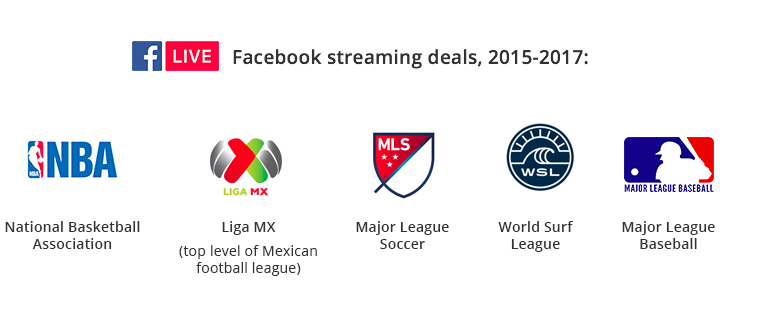
Conditions related to each of the above deals varied depending each sport’s popularity, the number of games etc. Games were usually streamed via the Facebook page of the relevant organisation, with stream sometimes limited geographically. But there’s no doubt that Facebook’s activity has started to position the social platform as a sports broadcaster in the making.
At this point, it’s worth mentioning the new Facebook platform, Watch. Launched in August 2017, it is a video service that hosts original content produced by Fox, Buzzfeed, Discovery Communications and Walt Disney, amongst others.[3]
For now, it is available in US only, but it’s only a matter of time when it will be available in other markets. Facebook Watch is undoubtedly a further, clearer statement about the company’s broadcasting future, with sports broadcasts and sports-themed shows part of its mix.
It’s not only Facebook fighting for rights
The battle for rights and ultimately audience share is not settled yet. There are many players striking deals:
- In April 2017, Amazon signed a deal to broadcast NFL games on its Prime service.
- Before Amazon, Twitter had rights to American Football, with the record game between Oakland Riders and Kansas City Chiefs watched online by 3.1 million at its peak; versus 17.4 million viewers via traditional TV. Funny fact: 12% of viewers weren’t even logged in to Twitter![4]
- CBS is an interesting example of a traditional broadcaster who’s creating a digital business in parallel. While broadcasting the NFL to its core TV audience, the channel also uses its OTT service – CBS All Access – to broadcast games digitally.
- Verizon Wireless paid $21 million for the rights to exclusively show the NFL game between Baltimore Ravens and Jacksonville Jaguars at London’s Wembley Stadium. If this isn’t absolutely crazy, we need to redefine ‘crazy’!
Why should you invest in broadcasting to social media?
On the face of it a simple question – why should you invest in broadcasting to social media? – but there are many ways to answer:
- Live video has the ability to improve all vital KPIs for social media: engagement rates, reach, views, and more.
- Online video content ad sales are growing faster than sales in traditional TV – 17% versus 4% respectively in 2016.[5]
- Younger generations are steadily moving to digital mediums as cord cutting gathers pace.
- In emerging markets like India, Thailand and Brazil, 25% of consumers are at least 14 years old, compared to 16% in developed markets. In only a few years these consumers will develop a heavier influence on markets.[6]
- For sports leagues, clubs and events outside of the top tier, digital broadcasting is a huge opportunity to engage with extremely loyal fans and reach out to new viewers world-wide. For example, the Henley Royal Regatta benefits from the innovative work of sports production company, Sunset+Vine, who use Tellyo to live stream the event to social media and create immediately shareable social video clips.
- In case of Twitter, let the numbers talk:
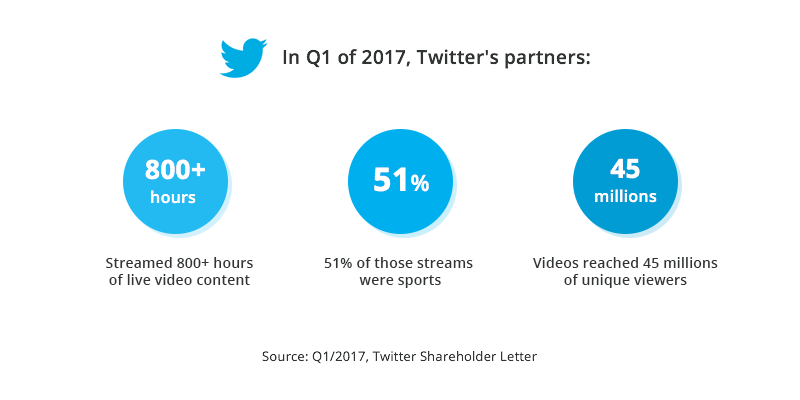
A quick note of positivity: the social media streaming market is still far from crowded and there’s plenty of room for a growth. This has never been truer for the companies, teams, associations or sport federations that are much smaller than Facebook, but who want to punch above their weight.
Social media and live sports – the perfect match
Social media platforms are natural extensions for TV broadcasters specialising in sports. But the social and online platforms themselves are muscling in, too. Big players like Twitter, Amazon and Facebook will continue to provide premium sports content to their vast audiences. They’re even proving hard to beat when it comes to buying (such as NFL streaming rights).
Yet, across the internet there’s plethora of sports fans happy to watch the sports they love. Even if not an entire game, these fans search out highlights, video summaries and blooper compilations. There is a golden opportunity to make these fans happy and show them what they want in an environment they love – the web.
So, what should you do? Simply include live streaming to social media and the creation of shareable video clips in your online strategy. And just go for it, champ!
Sources:
Make that leap and get your live video content onto social media
One of humankind’s greatest ever achievements – landing on the moon – was widely televised. It was a giant leap for humankind. But how will we all tune in when someone first walks on Mars? Most likely live via social media and on different devices – from smartphones to tablets and VRs.
But before we go that far, let’s get back to Earth for a second, and let the numbers talk!
The rise of live video content online
By 2019 video will be responsible for 80% of global internet traffic. Live video alone will consume 13% of internet video traffic by 2021. At the same time, in the United States, TV audiences dropped by 11% between 2010 and 2016.
Most predictions suggest a continued decline in traditional TV viewing, just as new viewing habits appear to be unstoppable. Audiences increasingly look for live video content online.
But while live video on social media is already huge, it’s not even close to saturation. With millennials and generation Z at the helm, the future of live video content looks bright and promising. Here are some steps you can take to get your live video onto social media.
Create a multi-channel strategy
The very first step to jumping on the social video bandwagon is to create a multi-channel strategy for your brand, incorporating the right channels for you.
When it comes to live video, Facebook is number one among social networks. It holds 45% of the social media streaming market share. Without doubt, Facebook is going to be a major platform for social media broadcasters for a long time.
“People spend more than 3x more time watching a Facebook Live video on average compared to a video that’s no longer live”[1]
The second most popular platform for live video content is YouTube, with 44% of video market share. It is rightly a natural place for live content, so when planning your presence on social media, don’t forget to consider Google’s flagship video platform.
Other significant social media broadcasting players are Instagram and Snapchat with 28% and 19% market share respectively.
Go multi-channel for the win
The importance of social media doesn’t mean it’s time to simply ditch traditional broadcasting platforms. It’s not about moving your business to the internet entirely. Rather, it’s about implementing a multi-channel strategy as soon as possible. One that will enable you to capture and engage with the huge audiences that exist online.
What the stats tell us, is that demand is huge. This is partly due to people’s preference for watching videos over reading text online (nearly two thirds of people on the internet prefer it this way). Other sources also point out that if you consider all videos on Facebook, including live broadcasts, that these are being viewed around 64 billion times daily! That’s a staggering amount of views, right?
What these stats mean is that the internet is full of people eager to watch live video broadcasts, as far as it’s related to their passions and interests.
Keep an eye on this fast-evolving environment
Today the MVPs may well be Facebook, YouTube, Instagram and Snapchat. But tomorrow – who knows?
One thing is for sure. If you can adapt the channels you use to get live video to your audiences as they want it, then you will succeed when it comes to social media.
As you can see, the above numbers speak for themselves. So why not make that leap and get your live video onto social media today!
[1] https://newsroom.fb.com/news/2016/03/news-feed-fyi-taking-into-account-live-video-when-ranking-feed/




